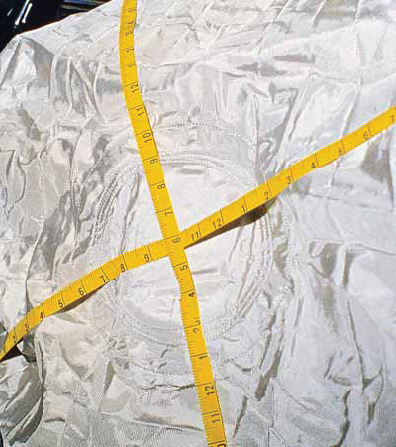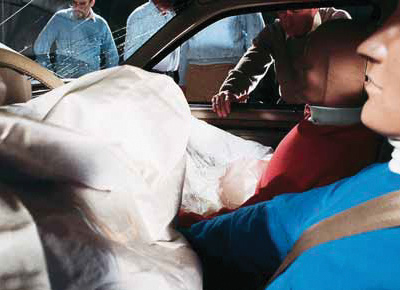

![]()
![]()
COUNTERFEIT AIR BAGS


NHTSA has become aware of a problem involving the sale of counterfeit air bags for use as replacement parts in vehicles that have been involved in a crash. While these air bags look nearly identical to certified, original equipment parts, including bearing the insignia and branding of major automakers, NHTSA testing showed consistent malfunctioning ranging from non-deployment of the air bag to the expulsion of metal shrapnel during deployment. NHTSA is not aware of any deaths or injuries connected to counterfeit air bags.
While the full scope and scale of the problem of counterfeit air bags is uncertain from currently available data, NHTSA has identified certain vehicle makes and models for which these air bags may be available and believes this issue affects less than 0.1 percent of the U.S. vehicle fleet. Only vehicles which have had an air bag replaced within the past three years by a repair shop that is not part of a new car dealership may be at risk.
Consumers whose vehicles have been in a crash and had their air bags replaced by a repair shop that is not part of a new car dealership within the past three years or who have purchased a replacement air bag online should contact the call center that has been established by their auto manufacturer to have their vehicle inspected at their own expense and their air bag replaced if necessary.
The full list of call centers and additional information are available at www.SaferCar.gov below.
NHTSA is currently gathering information from automakers about their systems for verifying the authenticity of replacement parts and is working with the industry to make the driving public aware of the potential safety risk posed by counterfeit air bags. Moving forward, the agency will continue to monitor consumer complaints, police accident reports, and other sources for additional information.
CONSUMERS THAT SHOULD NOT BE AT RISK
CONSUMERS THAT MAY BE AT RISK AND SHOULD CONTACT THE CALL CENTER ESTABLISHED BY THEIR AUTO MANUFACTURER
VEHICLES FOR WHICH COUNTERFEIT AIR BAGS MAY BE AVAILABLE:
As of today, NHTSA is aware of counterfeit air bags available for the following vehicle makes and models:
Make |
Model Year(s) |
Model(s) |
Acura |
2009-2011 |
TSX |
Audi |
2006-2009 |
A3, A4, A6, A8, Q5, Q7 |
BMW |
2007-2011 |
X5, E70, E60, E61 |
2008-2010 |
5-series, 528i, 535i |
|
2004-2007 |
5-Series, 525i, 530, 535, E60, E61 |
|
2007-2011 |
E90, E91 |
|
Not listed |
E92, E93 |
|
2007-2011 |
X5, E70 |
|
2004-2007 |
525i, 530, 535 |
|
2011-2012 |
X3 |
|
Buick |
2010-2011 |
Lacrosse |
Chevrolet |
2011-2012 |
Cruze |
2006-2010 |
Aveo |
|
2011-2012 |
Volt |
|
2012 |
Camaro |
|
Ford |
2012 |
Focus |
2005-2009 |
Mustang |
|
Honda |
2003-2012 |
Accord |
2006-2011 |
Civic |
|
2002-2011 |
CRV |
|
2007-2011 |
Fit |
|
2009-2011 |
Pilot |
|
2009-2011 |
Insight |
|
2009-2011 |
Crosstour |
|
2011 |
Odyssey |
|
Hyundai |
2007-2011 |
Elantra |
Not listed |
Genesis |
|
Not listed |
Sonata |
|
Infiniti |
2007-2011 |
G35, EX35 |
Kia |
2010-2011 |
Soul/Forte |
2004-2009 |
Spectra |
|
Land Rover |
2012 |
Range Rover Evoque |
Lexus |
2006-2011 |
IS250, IS350, IS-F |
2003-2008 |
GX470 |
|
2007-2009 |
RX350 |
|
Not listed |
ES350 |
|
Mazda |
2004 |
Mazda 3 |
2010-2012 |
Mazda 3 |
|
Mercedes |
2009-2011 |
C, GLK |
2010-2011 |
E350, E550 |
|
2007-2008 |
S550 |
|
2006-2009 |
ML |
|
2009-2010 |
GL, ML |
|
Mitsubishi |
Not listed |
Outlander |
Nissan |
1992-2002 |
Quest |
2010-2011 |
Quest |
|
2009-2011 |
Cube |
|
2007-2011 |
Versa |
|
2009-2010 |
Murano |
|
Not listed |
Altima |
|
Subaru |
2008-2009 |
Forester |
|
2008-2009 |
Imprezza |
|
2008-2009 |
Outback |
|
2010-2011 |
Legacy |
Suzuki |
2007-2010 |
SX4 |
Toyota |
2002-2006 |
Camry |
2012 |
Camry |
|
2009-2011 |
Corolla, Matrix |
|
2007-2011 |
Yaris |
|
2004-2011 |
Highlander |
|
2004-2011 |
Sienna |
|
2004-2011 |
Tacoma |
|
2010-2012 |
Prius |
|
2003-2006 |
Tundra |
|
2007-2011 |
Tundra |
|
2003-2006 |
Sequoia |
|
2003-2010 |
Land Cruiser |
|
2004-2007 |
Highlander |
|
2008-2010 |
Highlander |
|
2004-2009 |
4Runner |
|
2007-2009 |
Solara |
|
2005-2011 |
RAV4 |
|
Volkswagen |
2006-2010 |
Jetta |
Volvo |
Not listed |
XC60, XC70 |
Not listed |
V70, S60, S80 |
WHAT CONSUMERS SHOULD KNOW ABOUT COUNTERFEIT AIR BAGS
1. How can I tell if I have a counterfeit air bag?
YOU SHOULD NOT BE AT RISK IF:
YOU MAY BE AT RISK AND SHOULD CONTACT THE CALL CENTER ESTABLISHED BY YOUR AUTO MANUFACTURER IF:
2. What should I do if I think I have a counterfeit air bag in my car?
If you have reason to believe that your vehicle is equipped with a counterfeit airbag, the National Highway Traffic Safety Administration strongly urges you to contact the call center that has been established by your auto manufacturer or your local new car dealer to have your vehicle inspected at your own expense and your air bag replaced if necessary and visit www.SaferCar.gov for additional information.
3. Where do I find information for the call centers?
NHTSA has listed the phone numbers (Below) for the call centers that have been set up by the major auto manufacturers on www.SaferCar.gov. Consumers with vehicles that are not included in the list of manufacturers should contact their local new car dealer.
4. I purchased a used vehicle and do not know its full history. How can I determine if it has a counterfeit air bag?
Knowing the history of your used vehicle is an important step in making this determination. If you do not have full knowledge of your vehicle history you may want to get information using Carfax which can provide some helpful details or contact your local new car dealer to have your vehicle inspected at your own expense and your air bag replaced
if necessary.
5. Who is responsible for the cost of replacing the air bag if it is counterfeit?
The responsibility for replacing a counterfeit air bag will vary depending on the circumstances around the original installation of the part. If you are concerned about your vehicle, contact your local new car dealer to have your vehicle inspected at your own expense and your air bag replaced if necessary and visit www.SaferCar.gov for additional information.
In addition:
If you are concerned and have an air bag that was replaced at a repair shop recommended by your insurance company we recommend that you contact your insurance company.
If you purchased a counterfeit air bag from eBay it may be covered by that company’s “Buyer Protection” program. Contact eBay’s Customer Support center accessible on www.eBay.com.
You may also wish to contact your local Consumer Protection Agency or the appropriate State Office of the Attorney General to determine your rights under the law; and the Better Business Bureau or the Federal Trade Commission to file a complaint.
6. Where are the counterfeit air bags manufactured?
Based on what is known at this time, NHTSA and its partners have determined the counterfeit air bags were manufactured in Mainland China.
WHO TO CONTACT ABOUT COUNTERFEIT AIR BAGS
American Suzuki Motor Corporation • 1-800-934-0934
Acura Client Relations • 1-800-382-2238
Audi • 1-800-253-2834
BMW Group • 1-800-831-1117
Chrysler • 1-800-247-9753
Ford Motor Company • 1-800-392-3673 / 1-800-232-5952 (TDD)
General Motors • 1-866-237-3601
Honda Automobile Customer Service • 1-800-999-1009
Hyundai Motor America Consumer Affairs • 1-800-633-5151
Infiniti Consumer Affairs • 1-800-662-6200
Jaguar • 1-800-637-6837
Kia Consumer Assistance Center • 1-800-333-4542
Land Rover • 1-800-452-4827
Lexus • 1-800-255-3987
Mazda • 1-800-222-5500
Mercedes–Benz USA • 1-800-367-6372
Mitsubishi Motors • 1-888-648-7820
Nissan Consumer Affairs • 1-800-647-7261
Subaru of America, Inc. • 1-800-782-2783
Toyota • 1-800-331-4331
Volkswagen •1-800-822-8987
Volvo • 1-800-433-8236
RECOMMENDED DEALER GUIDANCE FOR MANAGING COUNTERFEIT AIR BAGS

DRIVER’S SIDE COUNTERFEIT AIR BAG INDICATORS
Counterfeit air bags are difficult to identify when installed in the vehicle. However, some visual clues that may indicate a counterfeit are:
For the air bag module still installed in the car:
For after the driver’s side air bag module is removed from the steering wheel:

NHTSA strongly advises technicians NOT to electrically probe counterfeit air bag connecting terminals because of the risk of detonation and possible serious injury.
The counterfeit air bag may have been rebuilt from a previously deployed air bag. Look for signs that the metal parts have been weakened by pyrotechnics, including burn marks or metals that have been stretched or expanded by the gases. The previously deployed air bag may have been removed from the module assembly and only the steering wheel trim cover has been replaced.
The supplemental restraint system fault detection system/warning lamp may have been deceived/deactivated using resistors or diodes. Dealers should obtain from manufacturers additional guidance for identifying genuine air bags in specific models, e.g., photographs of genuine air bags to compare with possible counterfeits.